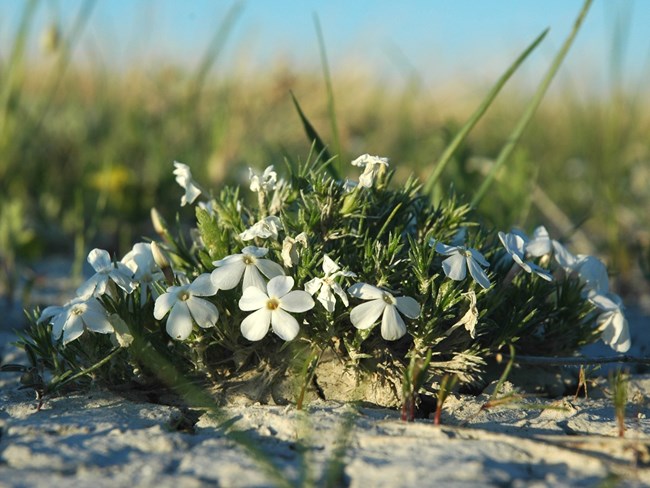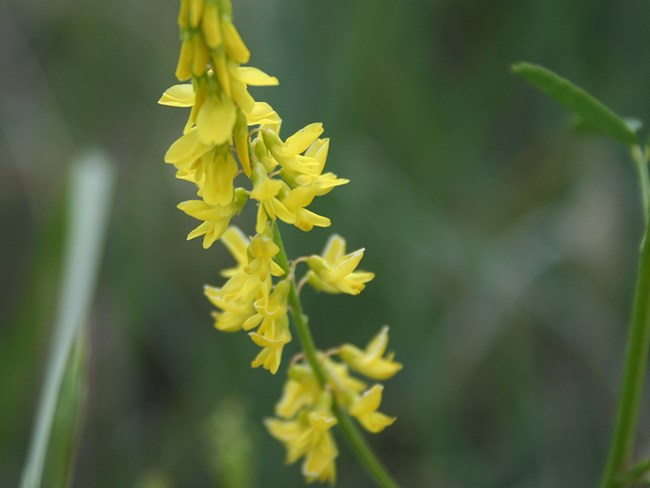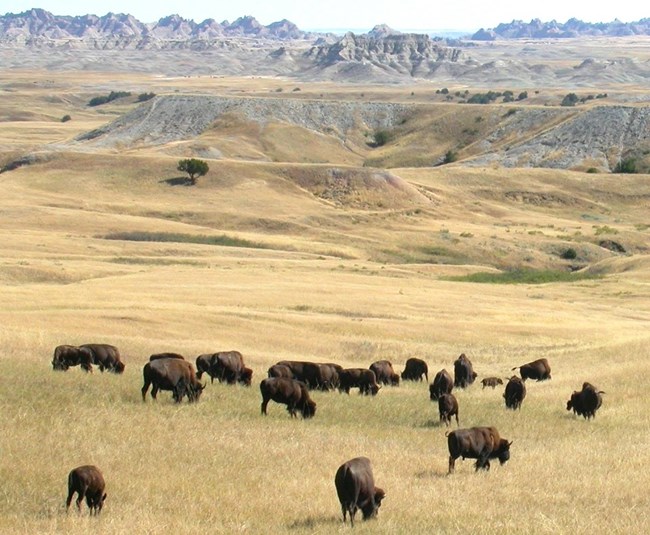Part of a series of articles titled Plant Community Monitoring in Northern Great Plains Network Parks.
Article
Plant Community Monitoring at Badlands National Park

NPS
Overview
Badlands National Park in southwestern South Dakota protects one of the largest expanses of mixed-grass prairie in the U.S. Roughly half of the park is covered with ankle-high and waist-high grasses. Trees, shrubs, and forbs (flowering plants that are not woody and not a grass or grass-like) grow here too, but grasses dominate the landscape. The park lies in a transitional zone between the moister tall-grass prairie habitats to the east and the more arid short-grass prairie to the west.
Prairie plants are sensitive to stressors, including invasive species, habitat fragmentation, climate change, pollution, and altered fire and grazing patterns. Park management actions, such as prescribed fire and exotic species control, may also affect plant communities. The Northern Great Plains Inventory and Monitoring Network conducts long-term monitoring of plant communities at Badlands National Park because it helps us better understand the current health of ecosystems and it can provide an early warning system of undesirable changes.

NPS
What We Monitor
We established plant monitoring plots throughout the park in 2011. A subset of these plots are monitored each year on a rotating basis. Additional plots are monitored in active burn units. At each plot, we record the native and exotic plant species found and the vegetation cover for each species, a measure of how much ground is covered by the plants. The NPS Northern Great Plains Fire Ecology Program began vegetation monitoring on the park in the late 1990s to evaluate the effectiveness of prescribed burns. The NPS Northern Great Plains Fire Ecology program began collaborating with us in 2011 to understand the effect of prescribed fires. The Fire Ecology Program monitors additional plots in active burn units.

NPS
Plant Communities in the Park
There are 444 plants on the Bandlands National Park plant list. In 2018, we identified 194 unique plant species in monitoring plots. More than 355 plant species have been found since we began monitoring plants in 1998. Graminoids (grasses, sedges, and rushes) accounted for most of the vegetation cover, but forbs, shrubs, and subshrubs (low-growing shrubs) are also present.
Seventy-six exotic plant species have been found; Japanese brome (Bromus japonicus), Kentucky bluegrass (Poa pratensis), and yellow sweetclover (Melilotus officinalis) are the most pervasive exotic plants on the park. Western wheatgrass (Pascopyrum smithii) is the most abundant native grass on the park. Only one rare plant, Barr's milkvetch (Astragalus barrii), has been detected during monitoring and it was found on only one plot.
More Details
- Badlands National Park has a moderate diversity of plants compared to other mixed-grass prairies, although there was some variation. The current number of species is affected by by many factors, such as how often fires occur, grazing, and weather fluctuations, as well as the history of mixed land-use practices at the park.
- There were no significant trends (increases or decreases) in the average number of plant species found at plots over time.
- The vegetation cover of exotic plants has remained high since 1998 with an average relative cover of 32.5% in monitoring plots.
- There were no relationships between the time since a prescribed burn and the number of native species or total plant cover of all exotic species, though exotic annual bromes did have less cover in plots that burned more recently. Reducing these exotic species will likely require other control methods, such as herbicide.
- Native plant diversity was higher in plots that were in bison pastures (where bison graze). Bison can influence the productivity and diversity of mixed-grass prairie through grazing and the creation of bison wallows, both of which limit the cover of dominant grasses, allowing more species to grow.

NPS
Did You Know?
During the last century, the Northern Great Plains experienced high levels of human-caused disturbance, including plowing for cropland, planting with non-natives to maximize livestock production, and other development. As a result, the Northern Great Plains prairie is now one of the most threatened ecosystems in the United States. Moderate disturbance in a prairie can contribute to diversity in grasslands, and some species grow better in slightly disturbed areas. However, high levels of disturbance, especially human-caused disturbances, often promote invasive or weedy species, allowing them to grow and spread. We are monitoring disturbances on the park to examine potential relationships between different types and levels of disturbance and prairie condition.
For More Information
Visit the Northern Great Plains Network website to read more about plant monitoring at Badlands National Park.
Protocol Contact, Northern Great Plains Inventory and Monitoring Network: Isabel Ashton
Summary by Northern Great Plains Network, updated in 2019
Last updated: July 28, 2020
